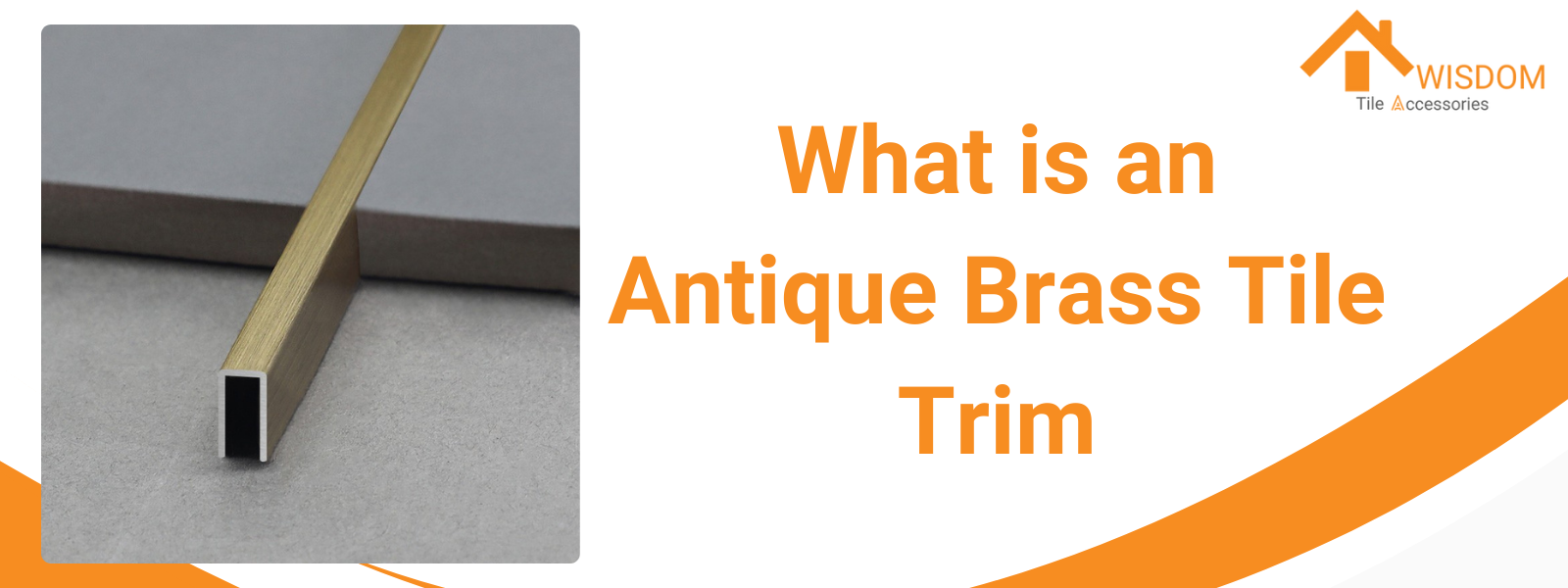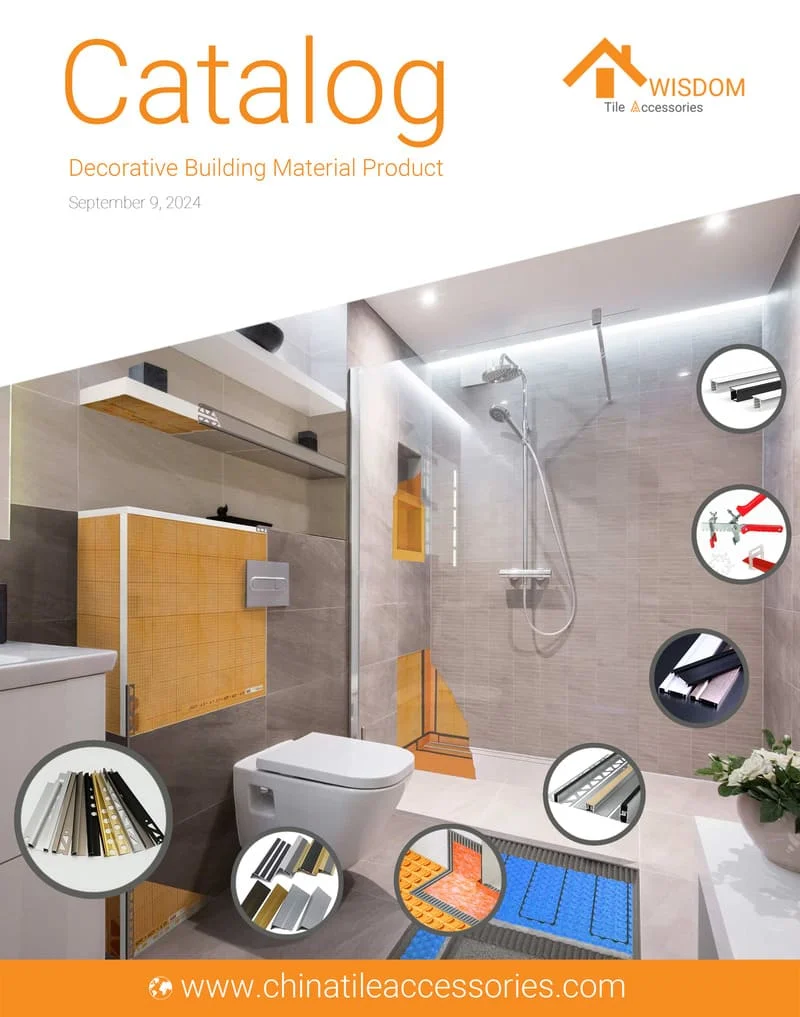Are you looking for the right tile edging trim for your project? In recent years, brass trim have gradually gained favor in the field of interior design. Welcome to read this guide, you will have an in-depth understanding of what antique brass tile trim is and feel its unique charm.

What is an Antique Brass Tile Trim
Antique brass tile trim, by its designation, refers to a finishing product used in the junctions and edges of tiled surfaces to create a visually appealing and durable boundary. This trim, distinct for its antique brass finish, is not merely an aesthetic choice but serves several functional purposes within architectural and interior design contexts.
The term "antique" in this context does not necessarily imply that the trim is old, but rather that it has undergone a treatment to acquire a patina or finish that mimics the appearance of aged brass. This finish is achieved through various chemical and mechanical processes, giving the brass a warm, golden-brown hue that evokes a sense of vintage elegance and timelessness. This characteristic makes antique brass tile trim especially suitable for projects that aim to capture a classic or period-specific aesthetic without sacrificing the benefits of modern manufacturing techniques.

From a material science perspective, brass is an alloy of copper and zinc, known for its durability, corrosion resistance, and antimicrobial properties. These attributes make brass an excellent choice for areas subject to moisture, such as bathrooms and kitchens, where the antimicrobial properties can also contribute to a more hygienic environment.
In terms of functionality, tile trims play a critical role in protecting the edges of tiles from chipping and wear, providing a smooth transition between different surfaces, and ensuring a neat finish that enhances the overall look of the tiled area. The use of antique brass tile trim, therefore, merges functionality with an aesthetic appeal, offering a solution that complements a wide range of interior designs from historical renovations to contemporary spaces seeking a touch of classic flair.
Why Use Brass Edging Trim?
Brass, as a material, brings forth an amalgamation of mechanical and chemical properties that render it exceptionally suited for use in diverse environments, especially those prone to moisture and wear.
Durability and Longevity
Brass is renowned for its robustness and resistance to corrosion, which is attributable to its composition of copper and zinc. This alloy demonstrates a remarkable ability to withstand the rigors of everyday use, making it an ideal choice for areas that endure heavy foot traffic or are susceptible to moisture, such as bathrooms, kitchens, and entryways. Its longevity is a key advantage, ensuring that the trim remains functional and visually appealing over extended periods.

Aesthetic Versatility
The unique golden hue of brass, especially when given an antique finish, offers a touch of elegance and warmth that can complement a wide range of interior styles. From contemporary to classic designs, brass edging trim can serve as a subtle yet impactful design element that enhances the overall aesthetic of a space. Its ability to integrate seamlessly with various tile designs and materials adds to its appeal as a versatile design choice.
Protective Qualities
One of the primary functions of tile trim is to safeguard the edges of tiles from chipping, cracking, and other forms of wear. Brass edging trim excels in this regard, providing a durable barrier that extends the lifespan of the tiled surface. Furthermore, it covers rough and sharp tile edges, reducing the risk of injuries and contributing to a safer environment for occupants.
Antimicrobial Properties
An often overlooked but significant benefit of brass is its inherent antimicrobial properties. This characteristic is particularly valuable in settings that demand high standards of hygiene, such as kitchens and bathrooms. By inhibiting the growth of bacteria and other pathogens, brass edging trim can play a role in maintaining cleaner surfaces and promoting a healthier living environment.
Ease of Maintenance
Despite its sophisticated appearance, brass edging trim is relatively easy to maintain. Regular cleaning with a soft cloth and mild detergent is typically sufficient to preserve its luster and prevent tarnishing. For those desiring to maintain the antique finish, specialized cleaning products can be used to protect the patina without diminishing its vintage appeal.
Thus, the choice of brass edging trim is justified not only by its aesthetic contribution to interior spaces but also by its functional attributes that include durability, protective qualities, antimicrobial properties, and ease of maintenance. These factors collectively make brass edging trim a prudent selection for both residential and commercial tiling projects, ensuring that the investment continues to deliver value and satisfaction long after its installation.
What Size Brass Trim to Use for Tiles?
The choice of trim size depends on several factors, including the thickness of the tiles being used and the type of edge or transition you are looking to create.
The general guideline is to opt for a tile trim that is one size larger than the depth of your tile. For instance, if your tiles are 10mm in thickness, a trim size of 12.5mm is recommended. This recommendation accounts for the adhesive layer that holds the trim and tile in place, ensuring that the depth of the trim matches the depth of the tile once installed. Such a choice facilitates a neat alignment between the tile and trim, providing a cohesive look while also accommodating the adhesive layer.


Tile trims come in various depths, ranging from 8mm up to 12.5mm, to cater to different tile thicknesses and installation requirements. It's essential to match the trim depth with the tile thickness, including the adhesive layer, to ensure a smooth transition and protect the tile edges effectively. For tiles that are 7mm thick, for example, a 10mm trim would be suitable to allow for the adhesive layer and ensure a proper fit.
When planning your tiling project, consider these guidelines to select the right size of brass tile trim. This will not only enhance the durability and appearance of your tiled surfaces but also ensure safety and functionality in areas like kitchens, bathrooms, and entryways where tile edges are exposed.
How to Clean Brass Tile Trim Correctly?
Maintaining and cleaning antique brass tile trim requires a thoughtful approach to preserve its aesthetic appeal and structural integrity. The key to effective maintenance lies in regular cleaning, using gentle methods, and avoiding harsh chemicals that could damage the antique finish.
Regular Cleaning
For regular upkeep, dusting weekly and a more thorough cleaning every few weeks are recommended. A simple solution of warm water and mild dish soap is often sufficient for cleaning brass tile trim, helping to remove dirt, grease, and grime without damaging the finish. It's crucial to use soft, non-abrasive cloths to avoid scratching the brass surface.
Avoiding Harsh Chemicals
Harsh cleaning agents can cause discoloration or tarnishing of brass. Instead, natural cleaners like vinegar and lemon are preferable. These substances can clean effectively without the adverse effects that stronger chemicals might have. For very tarnished brass, professional cleaning services might offer the expertise and appropriate products to restore the trim's original luster without causing harm.
Tackling Tarnish
Over time, brass tile trim can develop tarnish due to exposure to oxygen and moisture. A homemade paste of equal parts vinegar, flour, and salt can be applied to tarnished areas, left to sit for about 10-15 minutes, and then rinsed off with warm water. This method helps remove tarnish while being gentle on the brass surface.
Protecting Brass Trim
Applying a sealant to brass tile trim can provide an additional layer of protection against moisture and tarnishing. After cleaning and drying the brass surface thoroughly, a lacquer or other suitable sealant can be applied according to the manufacturer's instructions. This step helps maintain the trim's appearance and prolong its durability.
Professional Maintenance
For brass trim that is heavily tarnished or if you're unsure about the proper cleaning methods, consulting with professional cleaners can be a wise decision. They possess the knowledge and resources to effectively restore and maintain brass without causing damage.
In addition to these specific recommendations, it's also important to avoid using highly abrasive scrubbing tools, as these can scratch and damage the brass surface. For tarnish prevention, applying a thin coat of linseed oil or mineral oil after cleaning can help maintain the brass's shine.
FAQ about Antique Brass Tile Trim
What are the rules for tile trim?
The rules for installing tile trim emphasize selecting the right type, color, and material of trim to match or contrast your tiles for aesthetic harmony or visual impact. You should ensure the trim matches the thickness of your tile, taking into account the adhesive layer. For a professional finish, the depth of your trim should correspond to the tile depth, often choosing a trim slightly thicker than the tile to accommodate adhesive and ensure flush alignment.
Does tile trim go on first?
Tile trim should be installed concurrently with the tiling process, not before or after the tiles. As you lay your tiles, you'll integrate the trim into the tiled area to ensure it fits snugly against the tiles and is properly adhered. The trim is positioned and secured in place with adhesive or, in some cases, screws for additional support, especially on floors or heavy-duty areas.
Should tile trim be flush with tiles?
Yes, tile trim should be flush with the tiles for a seamless and professional appearance. This is achieved by selecting a trim thickness that matches or slightly exceeds the tile thickness, factoring in the adhesive layer. Ensuring the trim and tile surface align smoothly prevents edges from protruding and creates a visually appealing and safe transition.
What is the gap between trim and tile?
The gap between the trim and tile, typically filled with caulk or grout, varies depending on the tile size and the trim profile. This space is crucial for allowing a neat finish and accommodating material expansion. For most installations, leaving a small gap—enough for the grout or caulk to fill—is recommended to ensure a watertight seal, especially in wet areas. The exact size of this gap can be adjusted based on the specific requirements of the tile and trim used, but ensuring at least 2mm for grouting purposes is a common practice.


